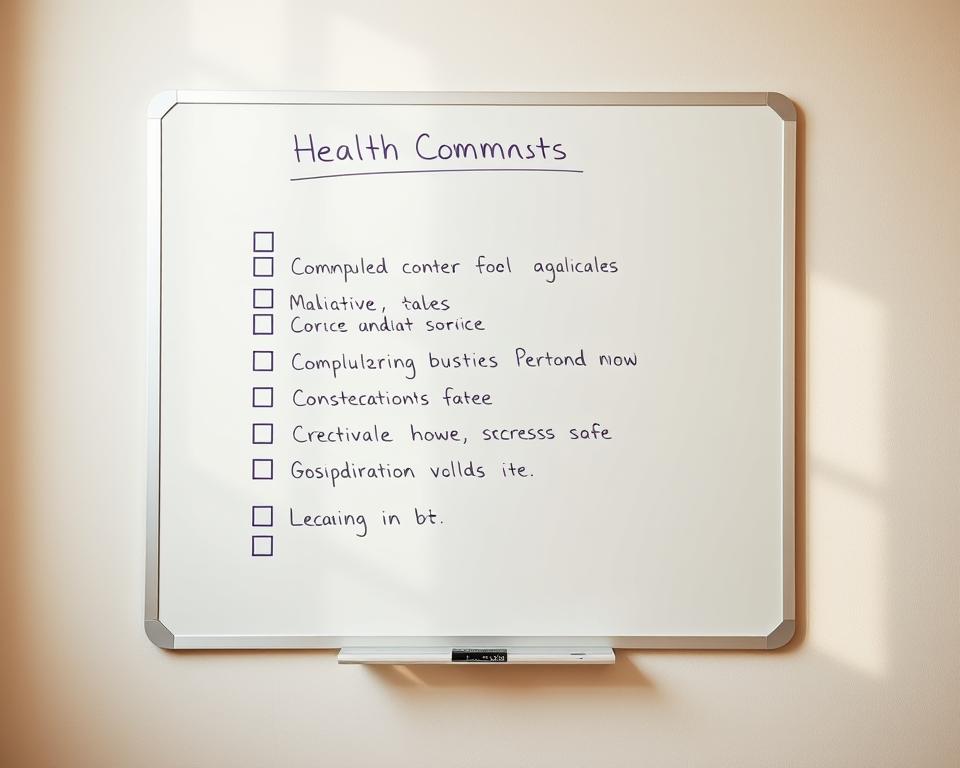Anúncios
health communication mistakes erode trust and safety, but you can prevent many of them with simple, evidence-informed practices your team can adopt today.
Why does clear exchange matter? When you listen, explain, and show respect, patients follow plans more closely, costs drop, and outcomes improve. Systems under pressure make slips more likely, and poor communication often drives inequity and mistrust—especially for Black patients and other minorities.
This guide is educational, not medical advice. You should consult qualified professionals for diagnosis or treatment.
You’ll learn to spot root causes, fix high‑risk habits like jargon and rushed instructions, use SBAR for handoffs, present absolute risks, embed teach‑back, and make EHRs and telehealth support—not replace—human connection. We’ll also cover cultural humility, interpreters, community partners, and workforce diversity to build trust and boost preventive care.
Start small: use plain language, involve your whole team, and favor absolute numbers when you explain benefits and risks. With empathy and practical steps, you can change a visit’s trajectory and make care fairer and safer for everyone.
Anúncios
Introduction: Why health communication mistakes still derail good care
Clear exchange matters: small lapses can change a patient’s course of care. When messages are rushed or vague, patients may miss tests, stop meds, or leave less confident in your team.
What’s at stake for outcomes, equity, and trust
Poor sharing of information harms outcomes and trust. Some groups face extra barriers and historical distrust, so respectful, plain talk is essential to fair care.
The role of healthtech, teams, and patient literacy
Technology and EHRs can support safer handoffs and follow-up. But tools do not replace listening. Limited time, complex instructions, and fragmented records create real risks.
Anúncios
Patients process information at different literacy levels. Use plain language and teach-back so they leave knowing the next steps without long visits.
How this guide helps you act with evidence and empathy
This guide gives evidence‑informed, practical tips you can use today in clinic, hospital, or virtual settings. It does not offer guarantees or medical advice.
- Team approach: every role—from front desk to physician—can reinforce the same message.
- Use absolute numbers: say “2 in 100” rather than only relative risk so patients judge benefit and harm more clearly.
Even brief check-ins can surface unanswered questions and prevent later confusion.
Root causes: System factors, bias, and training gaps you can actually fix
Hidden pressures shape what happens at the bedside. Tight schedules, crowded workflows, and sloppy handoffs create fragile moments where key details are lost during shift changes or referrals.
Common, fixable breakdowns include:
- Rushed workflows that drop critical details and create a handoff breakdown.
- Language and cultural barriers; interpreters help, but you must slow down and confirm meaning.
- Distrust from past harms—acknowledge it and practice cultural humility by asking and listening.
- Training blind spots: little practice with teach-back, sparse SDOH screening, and overreliance on lab values over stories.
Noisy clinics and weak privacy make sensitive conversations hard. Virtual visits help but have limits; set clear thresholds for when a symptom needs an in-person exam.
Simple steps you can use today: standardize handoffs with SBAR, add brief SDOH prompts to intake, use a language-access checklist, and create team habits so MAs, nurses, and physicians verify key details.
Policy and training shifts are uneven, but local checklists, scripts, and community links will improve interactions and build trust over time.

Health communication mistakes you should never normalize
Some routine habits in clinical talks quietly raise the chance of errors and confusion. You can stop many harms with a few concrete steps that make instructions clearer and safer.
Assuming understanding: jargon, relative risk framing, and rushed instructions
When you speak fast or use acronyms, patients often nod without grasping key points. Replace jargon with plain words and pause for questions.
Use absolute numbers. Instead of “50% reduction,” say “2 out of 100 people benefit.” That helps patients understand risks and benefits and supports shared decision-making.
Incomplete histories and medication lists that lead to errors
Skipping a full history or a clear med list causes real harm. The AFP case showed how missed meds and a phone diagnosis produced an avoidable error.
Ask about all prescriptions, over-the-counter drugs, and supplements. Document allergies and prior reactions in plain language so the next physician sees the same important information.
One-way talk: ignoring concerns, low participation, and no teach-back
Monologues hide obstacles. Invite concerns early: “What’s your biggest worry today?” and “What might get in the way of following this plan?”
Make teach-back standard: ask patients to restate the top two actions in their own words. This catches gaps and reduces errors.
- Ask about barriers to adherence; studies link clearer exchange to higher adherence—see an adherence study.
- Document follow-up plans and schedule a check when you start a new medication.
- Avoid phone-only diagnoses without targeted questions and a plan for in-person review if symptoms change.
Bottom line: slow down, use plain language, check understanding, and record key details. Respectful dialogue helps patients understand and reduces the odds of errors and wrong diagnoses.
Evidence check: How poor communication drives adverse events and costs
Simple questions left unasked are a common start to costly, preventable problems. Research links clearer exchange to better adherence, fewer errors, and higher patient satisfaction.
What studies show about adherence, errors, and patient satisfaction
One study found adherence rises from about 50% to roughly 70% when conversations are collaborative and clear. Seventy-one percent of nonadherence cases stemmed from patients not agreeing with or not understanding recommendations.
Clear dialogue also tracks with better glucose and blood pressure control, fewer medication errors, and improved reported outcomes. For more detail, see a relevant review at one study.

Real-world case: when missed questions trigger medication-related harm
A clinic started hydrochlorothiazide after two readings without full med reconciliation. The patient was fasting and active, developed severe hyponatremia and hypokalemia, and was called by phone with a mistaken diagnosis.
The issue resolved after stopping the drug, changing treatment, and scheduling clear follow-up. This case shows how small gaps in information and brief phone-only assessments can cascade into a hospital visit.
- Fixes that work: reconcile meds, explain side effects in plain words, use absolute risks, and set early follow-up.
- Structured handoffs and teach-back prevent events without adding much time.
- Document key facts so the next physician can act quickly and safely.
Takeaway: the right words, at the right time, avert harm and build trust.
Best practices to prevent poor communication in patient care
Small changes to how your team hands off care stop many slips before they start.
Standardize handoffs with SBAR and shared care plans
Adopt SBAR for every shift change and consult. Use a short script: Situation, Background, Assessment, Recommendation. This helps providers and clinicians share the same essentials fast.
Use plain language, teach-back, and absolute numbers
Explain diagnoses and instructions in simple words. Ask the patient to repeat the top two actions in their own words to confirm patients understand.
When you discuss risk, give absolute numbers: “2 out of 100 people” rather than vague terms. That helps patients make informed choices about treatment and medication.
Leverage EHRs and telehealth wisely
Use the EHR to reconcile meds, flag allergies, and store a visible shared care plan. But keep eye contact on video visits and pause to check understanding.
Set clear telehealth rules: what to handle virtually and when to convert to in-person care.
Document clearly and set follow-ups
Record history, meds, allergies, and patient preferences in a standard spot so any physician sees the same important information quickly.
Schedule follow-up calls or visits for new treatments or recent discharges and tell patients who to contact and when.
Practice and measure core skills
- Brief team huddles: one plain-language line, one teach-back prompt, one empathy statement.
- Use small audits to track if patients can explain their plan back.
- Celebrate fewer callbacks and clearer notes as wins.
These steps are practical, repeatable, and help your team deliver safer, fairer care.
Build trust and cultural humility across your team and community
Patients respond best when care teams meet them where they live and speak in ways that make sense.
Use professional interpreters, not ad hoc helpers. Speak directly to the patient, pause often, and invite questions to confirm understanding.
Partner with interpreters and community health workers
Include CHWs or promotores in visits and follow-ups. They bridge language gaps and share lived experience with patients.
Adopt cultural humility and diversify your workforce
Ask, don’t assume. Invite patients to describe beliefs or routines that shape care. Offer continuous bias training for providers and mentoring that grows diverse staff.
Engage trusted intermediaries
Work with churches, barbershops, and local leaders to host screenings like blood pressure checks. Trusted messengers often improve uptake and reduce distrust.
Integrate SDOH respectfully
Screen briefly for social needs, connect patients to services, and avoid overpromising results. Build feedback loops so community partners tell you what worked.
- Simple scripts: “What worries you most?” and “How would this fit your day?”
- Evidence note: one study showed concordant care can raise preventive uptake, improving outcomes.
Conclusion
Start small, and end every visit with a short, consistent close that leaves the patient confident about the next step.
Confirm the plan, name key warning symptoms, and give one clear contact for questions after hours. Use absolute numbers when you explain benefit or harm so patients grasp what to expect.
Pick one practice to begin today — teach-back, SBAR at handoff, or a simpler medication script — and repeat it at every encounter. Review one recent event with your team to spot a single fix you can standardize.
Better communication is a team sport: physicians, clinicians, and providers all shape patient care. Keep learning, use trusted community partners for language or blood‑pressure follow-up, and consult qualified professionals for diagnosis, treatment, or tailored guidance.



